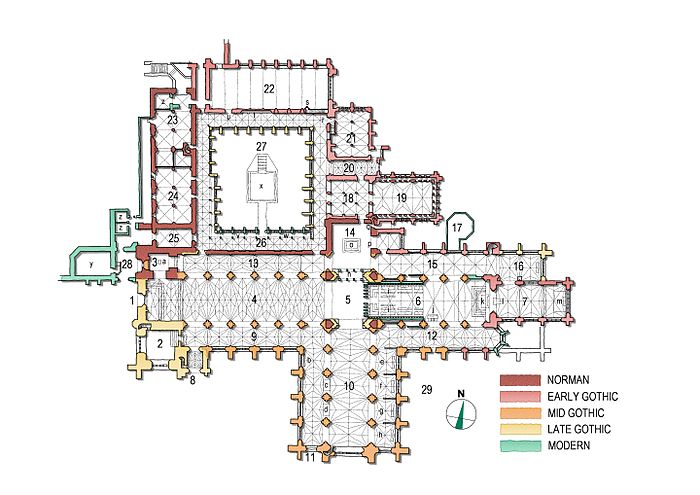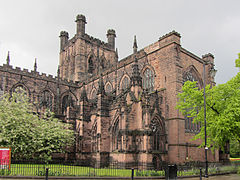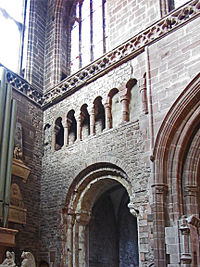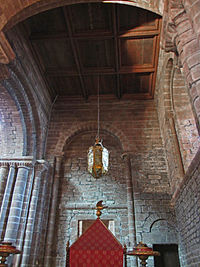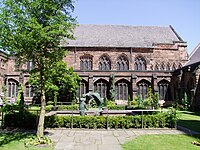Chester Cathedral
| Chester Cathedral | |
|
Cathedral Church of Christ | |
|---|---|
|
Chester, Cheshire | |
| Status: | cathedral |
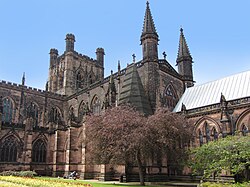 Chester Cathedral | |
| Church of England | |
| Diocese of Chester | |
| Location | |
| Grid reference: | SJ405664 |
| Location: | 53°11’31"N, 2°53’26"W |
| History | |
| Romanesque, Gothic | |
| Information | |
| Website: | www.chestercathedral.com |
The Cathedral Church of Christ and the Blessed Virgin Mary, more usually known as Chester Cathedral is the cathedral church of the Diocese of Chester. It stands in the heart of the City of Chester, county town of Cheshire.
The church was originally the abbey church of a Benedictine monastery, which was dissolved in 1539. The Diocese of Chester was created in 1541, and the church was designated its cathedral, which role it has retained ever since.
The cathedral is a Grade I listed building, and part of a heritage site that also includes the former monastic buildings to the north, which are also listed Grade I. All the major styles of mediæval architecture, from Norman to Perpendicular Gothic, are represented in the present building.[1][2]
The cathedral and former monastic buildings were extensively restored during the 19th century (amidst some controversy), and a free-standing bell-tower was added in the 20th century. The buildings are a major tourist attraction in Chester. In addition to holding services for Christian worship, the cathedral is used as a venue for concerts and exhibitions.
Contents
History
Middle Ages
Legend holds that there was on the site of today's cathedral a Roman basilica church dedicated to St Paul and St Peter.[3] This is supported by evidence that in Anglo-Saxon times the dedication of an early chapel on this site was changed from St Peter to St Werburgh.[4]
During the Dark Ages, Barloc of Norbury, a Celtic saint and hermit,[5] was venerated at Chester Cathedral with a feast day on 10 September. He is known to history mainly through the hagiography of the Secgan Manuscript;[6] he also occurs in a litany in the Tanner of the Bodleian Library, Oxford.[7]
In the 10th century, St Werburgh's remains were brought to Chester, and 907 AD her shrine was placed in the church.[8] It is thought that Æthelfleda turned the church into a college of secular canons, and that it was given a charter by King Edgar in 968. The collegiate church, as it was then, was restored in 1057 by Leofric, Earl of Mercia and Lady Godiva. This church was razed to the ground around 1090, with the secular canons evicted, and no known trace of it remains.[9]
In 1093 a Benedictine abbey was established on the site by Hugh Lupus, Earl of Chester, with the assistance of St Anselm and other monks from Bec in Normandy. The earliest surviving parts of the structure date from that time. The abbey church was not at that time the cathedral of Chester; from 1075 to 1082 the cathedral of the diocese was the nearby church of St John the Baptist, after which the see was transferred to Coventry.[10]
Modern Period
In 1538, during the dissolution of the monasteries, the monastery was disbanded and the shrine of Saint Werburgh was desecrated.[11] In 1541 St Werburgh's abbey became a cathedral of the Church of England, by order of King Henry VIII. At the same time, the dedication was changed to Christ and the Blessed Virgin. The last abbot of St Werburgh’s Abbey, Thomas Clarke, became the first Dean of the new cathedral.[12]
Although little trace of the 10th-century church has been discovered, save possibly some Saxon masonry found during a 1997 excavation of the nave,[13] there is much evidence of the monastery of 1093. This work in the Norman style may be seen in the northwest tower, the north transept and in remaining parts of the monastic buildings.[11] The abbey church, beginning with the Lady Chapel at the eastern end, was extensively rebuilt in Gothic style during the 13th and 14th centuries. At the time of the dissolution of the monasteries, the cloister, the central tower, a new south transept, the large west window and a new entrance porch to the south had just been built in the Perpendicular Gothic style, and the southwest tower of the façade had been begun.[1] The west front was given a Tudor entrance, but the tower was never completed.[2]
In 1636 the space beneath the south west tower became a bishop's consistory court. It was furnished as such at that time, and is now a unique survival in England, hearing its last case, that of an attempted suicide of a priest, in the 1930s.[11][14] Until 1881, the south transept, which is unusually large, also took on a separate function as an independent ecclesiastical entity: the parish church of St Oswald.[15] Although the 17th century saw additions to the furnishings and fittings, there was no further building work for several centuries. By the 19th century, the building was badly in need of restoration. The present homogeneous appearance that the cathedral presents from many exterior angles is largely the work of Victorian restorers, particularly George Gilbert Scott.[16]
The 20th century has seen continued maintenance and restoration. In 1922, the Chester War Memorial was installed in the cathedral grounds and dedicated to the fallen soldiers of the First World War and later the Second World War.[17] In 1973–75 a detached belfry, designed by George Pace, was erected in the grounds of the cathedral.[2] In 2005 a new Song School was added to the cathedral.[8] During the 2000s, the cathedral library was refurbished and relocated. It was officially reopened in September 2007.[18] The cathedral and the former monastic buildings were designated as Grade I listed buildings on 28 July 1955.[2][19]
Architecture
Cathedral plan
Chester Cathedral has an east-west axis, common to many cathedrals, with the chancel at the eastern end, and the façade to the west. The plan is cruciform, with a central tower (as is usual in English monastic churches), but is asymmetrical, having a small transept on the north side remaining from an earlier building, and an unusually large south transept. As the plan shows, the asymmetry extends to the west front, where the north tower remains from the Norman building, and the south tower is of the early 16th century. At the eastern end, the symmetrical arrangement of the aisles was lost when the end of the south aisle was demolished and rebuilt in an apsidal shape. The nave, choir and south transept have wide aisles on either side, and are lit by clerestory windows and large multi-light windows in each of the three cliff-like ends. To the north of the cathedral are monastic buildings, including the cloister, refectory and a rectangular chapter house. The façade of the building is abutted on the north by later buildings.[2]
|
1. West door |
16. St. Werburgh's Chapel |
a. Font |
n. organ |
External appearance
LIke the cathedrals of Carlisle, Lichfield and Worcester, Chester Cathedral is built of New Red Sandstone, in this case from the Cheshire Basin. The stone lends itself to detailed carving, but is also friable, easily eroded by rain and wind, and is badly affected by pollution. With the other red sandstone buildings, Chester is one of the most heavily restored of the Church of England's cathedrals. The restoration, which included much refacing and many new details, took place mainly in the 19th century.[20]
Because the south transept is similar in dimension to the nave and choir, views of the building from the south-east and south-west give the impression of a building balanced around a central axis, with its tower as the hub. The tower is of the late 15th century Perpendicular style, but its four large battlemented turrets are the work of the restoration architect George Gilbert Scott.[2]
With its rhythmic arrangement of large, traceried windows, pinnacles, battlements and buttresses, the exterior of Chester Cathedral from the south presents a fairly homogeneous character, which is an unusual feature as England's cathedrals are in general noted for their stylistic diversity.[21] Close examination reveals window tracery of several building stages from the 13th to the early 16th century. The richness of the 13th-century tracery is accentuated by the presence of ornate, crocketted drip-mouldings around the windows; those around the perpendicular windows are of simpler form.
The façade of the cathedral is dominated by a large deeply recessed eight-light window in the Perpendicular style,[22] above a recessed doorway set in a screen-like porch designed, probably by Seth and George Derwall, in the early 1500s.[1][22] This porch formed part of the same late 15th-century building programme as the south transept, central and southwest towers, and cloister.[1] Neither of the west towers was completed.[3] To the north is the lower stage of a Norman tower, while to the south is the lower stage of a tower designed and begun, probably by Seth and George Derwall, in 1508,[1] but left incomplete following the dissolution of the monastery in 1538. The cathedral's façade is abutted on the north by a Victorian building housing the education centre and largely obscured from view by the building previously used as the King's School, which is now a branch of Barclays Bank.[23] The door of the west front is not used as the normal entrance to the cathedral, which is through the southwest porch which is in an ornate Tudor style.
Interior
The interior of Chester Cathedral gives a warm and mellow appearance because of the pinkish colour of the sandstone. The proportions appear spacious because the view from the west end of the nave to the east end is unimpeded by a pulpitum and the nave, although not long, is both wide and high compared with many of England's cathedrals. The piers of the nave and choir are widely spaced, those of the nave carrying only the clerestory of large windows with no triforium gallery. The proportions are made possible partly because the ornate stellar vault, like that at York Minster, is of wood, not stone.[11][24]
Former monastic buildings
The Perpendicular Gothic cloister is entered from the cathedral through a Norman doorway in the north aisle. The cloister is part of the building programme that commenced in the 1490s and is probably the work of Seth Derwall.[1] The south wall of the cloister, dating from the later part of the Norman period, forms the north wall of the nave of the cathedral, and includes blind arcade|blind arcading.[25] Among the earliest remaining structures on the site is an undercroft off the west range of the cloisters, which dates from the early 12th century, and which was originally used by the monks for storing food. It consists of two naves with groin vaults and short round piers with round scalloped capitals.[2]
Leading from the south of the undercroft is the abbot's passage which dates from around 1150 and consists of two bays with rib-vaulting.[26] Above the abbot's passage, approached by a stairway from the west cloister, is St Anselm's Chapel which also dates from the 12th century. It is in three bays and has a 19th century Gothic-style plaster vault. The chancel is in one bay and was remodelled in the early 17th century. The screen, altar rails, holy table and plaster ceiling of the chancel date from the 17th century.[26] The north range of the cloister gives access to a refectory, built by Simon de Whitchurch in the 13th century. It contains an Early English pulpit, approached by a staircase with an ascending arcade. The only other similar pulpit in England is in Beaulieu Abbey.
Restoration
By the 19th century the fabric of the building had become badly weathered, with Charles Hiatt writing that "the surface rot of the very perishable red sandstone, of which the cathedral was built, was positively unsightly" and that the "whole place previous to restoration struck one as woebegone and neglected; it perpetually seemed to hover on the verge of collapse, and yet was without a trace of the romance of the average ruin".[3] Between 1818 and 1820 the architect Thomas Harrison restored the south transept, adding corner turrets.[23] This part of the building served until 1881 as the parish church of St Oswald, and it was ecclesiastically separate.[15] From 1844 R. C. Hussey carried out a limited restoration including work on the south side of the nave.[2]
The most extensive restoration was carried out by the Gothic Revival architect, George Gilbert Scott, who between 1868 and 1876 "almost entirely re-cased" the cathedral.[22][11] The current building is acknowledged to be mainly the product of this Victorian restoration commissioned by the Dean, John Saul Howson.[12] In addition to extensive additions and alterations to the body of the church, Scott remodelled the tower, adding turrets and crenellations.[2] Scott chose sandstone from the quarries at Runcorn for his restoration work.[27] In addition to the restoration of the fabric of the building, Scott designed internal fittings such as the choir screen to replace those destroyed during the Civil War. He built the fan vault of the south porch, renewed the wooden vault of the choir and added a great many decorative features to the interior.
Scott's restorations were not without their critics and caused much debate in architectural circles. Scott claimed to have archaeological evidence for his work, but the Liverpool architect, Samuel Huggins argued in an 1868 address to the Liverpool Architectural Society, that the alterations were less like restoration and more like rebuilding. One of the larger changes was to shorten the south aisle and restyle it as an apse. The changes also proposed the addition of a spire above the existing tower, but this proposal was later rejected. Samuel's further paper of 1871 entitled On so-called restorations of our cathedral and abbey churches compelled the Dean to attempt to answer the criticism. The debate contributed to the establishment of the Society for the Protection of Ancient Buildings.[28]
Later in the century, from 1882, Arthur Blomfield and his son Charles made further additions and modifications, including restoring and reinstating the Shrine of St Werburgh. More work was carried out in the 20th century by Giles Gilbert Scott between 1891 and 1913, and by F. H. Crossley in 1939.[2]
Bell tower
Towards the end of 1963 the cathedral bells, which were housed in the central tower, were in need of an overhaul and ringing was suspended. In 1965 the Dean asked George Pace, architect to York Minster, to prepare specifications for a new bell frame and for electrification of the clock and tolling mechanism. Due to structural difficulties and the cost of replacing the bells in the central tower it was advised that consideration should be given to building a detached bell and clock tower in the southeast corner of the churchyard. It was decided to proceed with that plan, and in 1969 an announcement was made that the first detached cathedral bell tower was to be erected since the building of the campanile at Chichester Cathedral in the 15th century. In February 1969, nine of the ten bells in the central tower were removed to be recast by John Taylor & Co as a ring of twelve bells with a flat sixth.[29] The new bells were cast in 1973.[30] Work on the new bell-tower began in February 1973. Two old bells dating from 1606 and 1626 were left in the tower. On 26 February 1975 the bells were rung for the first time to celebrate the wedding of a member of the Grosvenor family. The official opening on 25 June 1975 was performed by the Duke of Gloucester. The belfry is known as the Dean Addleshaw Tower, after the Dean of the cathedral responsible for its construction.[29] The tower is built in concrete, faced with sandstone at its base. It is the first detached bell tower to be built for a cathedral in this country since the Reformation.[31] Between the bell tower and the south transept is a garden in remembrance of the Cheshire Regiment (originally the 22nd Regiment of Foot).[13]Choir
The most famous feature of the choir is the set of choir stalls, dating from about 1380, and described above. The lectern, in the form of a wooden eagle, symbol of John the Evangelist, dates from the first half of the 17th century.[32] The candlesticks also date from the 17th century and are by Censore of Bologna who died in 1662.
With these exceptions, most of the decoration and the fittings of the choir date from the 19th century and are in keeping with the Gothic Revival promoted by the Oxford Movement and Augustus Welby Pugin. The restored vault of the choir is typical of the period, having been designed by Scott and decorated and gilded by Clayton and Bell.
The choir is entered through a screen designed by George Gilbert Scott, with gates made by Skidmore. The rood was designed by Scott, and was made by F. Stuflesser.[2] The bishop's throne or “cathedra” was designed by Scott to complement the choir stalls. It was constructed by Farmer and Brindley in 1876. The reredos and the floor mosaic date from 1876, and were designed by J. R. Clayton. The east window has tracery of an elegant Decorated Gothic design which is filled with stained glass of 1884 by Heaton, Butler and Bayne.
Cloisters and refectory
The cloisters were restored in the 20th century, and the stained glass windows contain the images of some 130 saints. The cloister garth contains a modern sculpture entitled The water of life by Stephen Broadbent.[33] The refectory roof is dated 1939 and was designed by F. H. Crossley.[34] The east window with reticulated tracery was designed by Giles Gilbert Scott and is dated 1913.[35] The stained glass in the west window, depicting the Creation, was designed by Ros Grimshaw and installed in 2001 to celebrate the Millennium. On the refectory's west wall there is a tapestry depicting Elymas being struck with blindness which was woven at Mortlake in the 17th century from a cartoon by Raphael. The heraldic paintings on the north wall represent the arms of the Earls of Chester.
Music
The hymn-writer William Cooke (1821–1894) was a canon of Chester.[36]
Organ
In 1844, an organ by Gray & Davison of London was installed in the cathedral, replacing an instrument with parts dating back to 1626. The organ was rebuilt and enlarged by Whiteley Bros of Chester in 1876, to include harmonic flutes and reeds by Cavaillé-Coll. It was later moved to its present position at the front of the north transept. In 1910 William Hill and Son of London extensively rebuilt and revoiced the organ, replacing the Cavaillé-Coll reeds with new pipes of their own. The choir division of the organ was enlarged and moved behind the choirstalls on the south side. The instrument was again overhauled by Rushworth and Dreaper of Liverpool in 1969, when a new mechanism and some new pipework made to a design by the organist, Roger Fisher, was installed. Since 1991 the organ has been in the care of David Wells of Liverpool.[37]
Choirs
The choral tradition at Chester is 900 years old, dating from the foundation of the Bendedictine monastery. In 1741 Handel heard the first recital of his Messiah at Chester.[14] There are usually eight choral services in the cathedral each week. Chester has a cathedral choir of male lay clerks, choral scholars, and boy and girl choristers. They rehearse in the Song School, built on the site of the former Monks' Dormitory. In addition to singing at services, the choir perform in concerts, tour abroad, and make recording on CDs. There is no choir school at Chester, so the choristers come from local schools.[38] There is also a mixed choir of adults, the Nave Choir, which sings Compline on Sunday evenings and in other services. This choir also takes part in concerts, and undertakes tours. Having been founded during the 1860s, it is the longest-running voluntary cathedral choir in Britain.[39]
Outside links
| ("Wikimedia Commons" has material about Chester Cathedral) |
- Chester Cathedral & its Historic Links with New York
- A tour of Chester Cathedral
- Chester Cathedral in the Corpus of Romanesque Sculpture in Britain and Ireland
- Details of organ
- British History Online
- Aerial photograph
- Photographs from Art and Architecture
- Plan of the cathedral
- Mediæval stained glass from CVMA
- Photographs and panorama
- The Chester Virtual Stroll Cathedral pages
- The Chester Cathedral Old Choristers Association pages
- Chester Cathedral Quarter – development project
- Chester Cathedral Nave Choir Website
References
- ↑ 1.0 1.1 1.2 1.3 1.4 1.5 Harvey 1961, p. 125.
- ↑ 2.00 2.01 2.02 2.03 2.04 2.05 2.06 2.07 2.08 2.09 2.10 National Heritage List 1376398: Cathedral Church of Christ and the Blessed Virgin Mary, Chester
- ↑ 3.0 3.1 3.2 Home 1925, p. 14.
- ↑ Richards 1947, pp. 93–94.
- ↑ Barloc of Norbury in The Oxford Dictionary of Saints
- ↑ Stowe MS 944, British Library
- ↑ Barloc at Answers.com
- ↑ 8.0 8.1 "History". Chester Cathedral. Archived from the original on 27 June 2007. http://web.archive.org/web/20070627183052/http://www.chestercathedral.com/website_pages/history.asp. Retrieved 15 February 2008.
- ↑ Home 1925, pp. 18–23.
- ↑ St John the Baptist, Chester, Cheshire. The Corpus of Romanesque Sculpture in Britain and Ireland. http://www.crsbi.ac.uk/search/county/site/ed-ch-chsjb.html. Retrieved 13 June 2010
- ↑ 11.0 11.1 11.2 11.3 11.4 Tatton-Brown & Crook 2002, pp. 94–95.
- ↑ 12.0 12.1 Chester Cathedral
- ↑ 13.0 13.1 "Chester Tourist". Chester Tourist.com. http://www.chestertourist.com/cathedral.htm. Retrieved 18 March 2008.
- ↑ 14.0 14.1 Bowerman 1996, p. 1
- ↑ 15.0 15.1 Richards 1947, p. 95.
- ↑ Hartwell et al. 2011, p. 220.
- ↑ Morris & Roberts 2012, pp. 87–90.
- ↑ Nuttall 2009, p. 20.
- ↑ National Heritage List 1376397: Former monastic buildings to Cathedral Church of Christ and the Blessed Virgin Mary, Chester
- ↑ Clifton-Taylor 1967, pp. 110–113.
- ↑ Pevsner & Hubbard 2003, pp. 136–138.
- ↑ 22.0 22.1 22.2 Richards 1947, p. 94.
- ↑ 23.0 23.1 Pevsner & Hubbard 2003, p. 137.
- ↑ Clifton-Taylor 1967, p. 266.
- ↑ Pevsner & Hubbard 2003, pp. 145–146.
- ↑ 26.0 26.1 Pevsner & Hubbard 2003, p. 145.
- ↑ Starkey 1990, p. 149
- ↑ Nicholson, Nicholson, rev Valerie Scott (2004), "Huggins, Samuel (1811–1885)", Oxford Dictionary of National Biography (Oxford University Press), http://www.oxforddnb.com/view/article/202010, retrieved 5 July 2013 ((subscription or UK public library membership required))
- ↑ 29.0 29.1 Lewis, C. Kenneth (1987). "Dean Addleshaw Tower". Chester Diocesan Guild of Church Bell Ringers. Archived from the original on 23 August 2006. http://web.archive.org/web/20060823193208/http://www.wirral8.f9.co.uk/chesterdg/addleshaw.htm. Retrieved 28 February 2008.
- ↑ "Chester, Cath Ch of Christ & BVM". Dove's Guide for Church Bell Ringers. Central Council for Church Bell Ringers. 4 May 2007. http://dove.cccbr.org.uk/detail.php?searchString=chester&DoveID=CHESTR. Retrieved 17 July 2008.
- ↑ "Bell Tower". Chester City Council. http://www.virtualchester.org/view/view_location.php?id=4. Retrieved 28 July 2009.
- ↑ Richards 1947, pp. 95–96.
- ↑ "Chester Cathedral Cloister Garth". visitchester.com. http://www.visitchester.com/site/experiences/chester-cathedral-cloister-garth-p100061. Retrieved 18 October 2009.
- ↑ , Pevsner & Hubbard 2003, p. 147.
- ↑ Pevsner & Hubbard 2003, pp. 137–138.
- ↑ Samuel Willoughby Duffield, English Hymns: Their Authors and History (1886), p. 358
- ↑ The Organ, Chester Cathedral, archived from the original on 16 January 2012, http://web.archive.org/web/20120116144724/http://www.chestercathedral.com/chester-cathedral-organ-history.htm, retrieved 28 February 2008
- ↑ Cathedral Choir, Chester Cathedral, http://www.chestercathedral.com/music/cathedral-choir.html, retrieved 5 July 2013
- ↑ Nave Choir, Chester Cathedral, http://www.chestercathedral.com/music/nave-choir.html, retrieved 5 July 2013
- Bowerman, Anthony (1996), Chester Cathedral, The Secret Past, Chester: Chester Cathedral, ISBN 0-9522434-2-3
- Alec Clifton-Taylor (1967), The Cathedrals of England, London: Thames and Hudson, ISBN 0-500-20062-9
- Cowen, Painton (2003), Six Days: The Story of the making of the Chester Cathedral Creation Window, Bristol: Alastair Sawday Publishing, ISBN 1-901970-33-7
- Nikolaus Pevsner: The Buildings of England: Cheshire, 1971; 2011 Penguin Books ISBN 978-0-300-09588-3
- Harvey, John (1961) [1950], English cathedrals (Third ed.), London: Batsford, OCLC 2683041
- Home, Beatrice (1925), Gordon Home, ed., Cathedrals, Abbeys and Famous Churches — Chester, Manchester and Liverpool, J. M. Dent & Sons Ltd, OCLC 1681547
- Hiatt, Charles (1911) [1898], The cathedral church of Chester; a description of the fabric and a brief history of the episcopal see, London: G. Bell, pp. 115, OCLC 841718720, https://archive.org/details/cathedralchurch02hiatgoog
- Morris, Edward; Roberts, Emma (2012), Public Sculpture of Cheshire and Merseyside (excluding Liverpool), Public Sculpture of Britain, 15, Liverpool: Liverpool University Press, ISBN 978-1-84631-492-6
- Nuttall, Derek (2009), "Chester Cathedral Library", Cheshire History (Chester: Cheshire Local History Association) 49, SSN 0141-8696
- Nikolaus Pevsner: The Buildings of England: Cheshire, 1971; 2011 Penguin Books ISBN 978-0-300-09588-3
- Richards, Raymond (1947), Old Cheshire Churches, London: Batsford, OCLC 719918
- Sheehan, Bernie (2003). Chester Cathedral. Jarrold Publishing. ISBN 0-7117-3090-3.
- Starkey, H. F. (1990), Old Runcorn, Halton: Halton Borough Council
- Tatton-Brown, Tim; Crook, John (2002), The English Cathedral, London: New Holland, ISBN 1-84330-120-2
| Cathedrals of the Church of England |
|---|
|
Province of York:
Blackburn •
Bradford •
Carlisle •
Chester •
Durham •
Liverpool •
Manchester •
Newcastle upon Tyne •
Peel •
Ripon •
Sheffield •
Southwell •
Wakefield •
York
|

